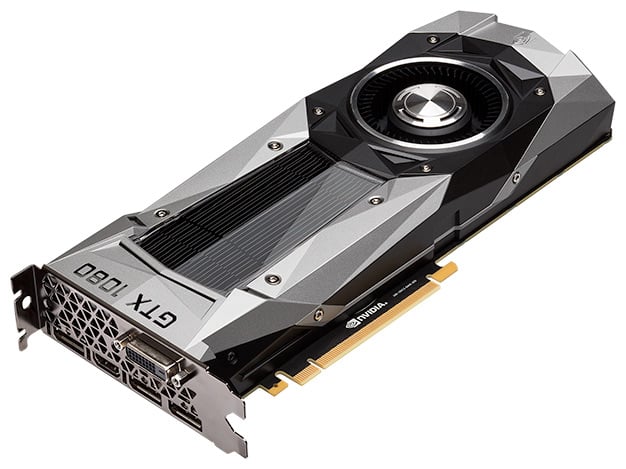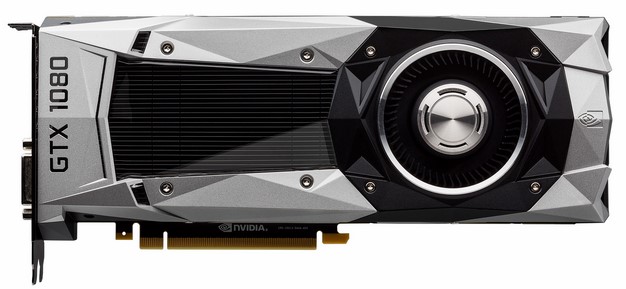NVIDIA GeForce GTX 1080 Performance Review: Pascal, The New King
Introducing The GeForce GTX 1080
A couple of weeks back, at a packed event in Austin, Texas filled with tech press and attendees from the DreamHack gaming event that took place up the road, NVIDIA CEO Jen Hsun-Huang unveiled the company’s newest graphics cards, the GeForce GTX 1080 and GeForce GTX 1070. These latest flagships represent a true generational leap in performance and efficiency, thanks to NVIDIA's new Pascal GPU architecture at their core and the bleeding-edge 16nm FinFET + VLSI manufacturing processes used to produce the chips. For the last few years, virtually all of the discrete GPUs being produced used a 28nm process.
Mr. Huang made some lofty claims in regards to the GeForce GTX 1080’s efficiency and performance, and unveiled a number of new, interesting features as well, which worked the crowd up at the event into a frenzy. On site demos of the GTX 1080 were equally impressive. When we left the event, we couldn’t wait to get our hands on a card to evaluate its power and performance for ourselves.
Thankfully, it wasn’t long until we had a GeForce GTX 1080 in hand. And today, 10 days before they are due to hit store shelves, we’re able to give you the full scoop. On the pages ahead, we’ve detailed all of the GeForce GTX 1080’s new features and evaluated its performance with an array of applications and games. Before we get to the meaty stuff though, we’ve got some specifications and some up-close-and-personal pics of the card to share...
Mr. Huang made some lofty claims in regards to the GeForce GTX 1080’s efficiency and performance, and unveiled a number of new, interesting features as well, which worked the crowd up at the event into a frenzy. On site demos of the GTX 1080 were equally impressive. When we left the event, we couldn’t wait to get our hands on a card to evaluate its power and performance for ourselves.
Thankfully, it wasn’t long until we had a GeForce GTX 1080 in hand. And today, 10 days before they are due to hit store shelves, we’re able to give you the full scoop. On the pages ahead, we’ve detailed all of the GeForce GTX 1080’s new features and evaluated its performance with an array of applications and games. Before we get to the meaty stuff though, we’ve got some specifications and some up-close-and-personal pics of the card to share...
|
| NVIDIA GeForce GTX 1080 | ||
| Graphics Processing Clusters | 4 | |
| Streaming Multiprocessors | 20 | |
| CUDA Cores (single precision) | 2560 | |
| Texture Units | 160 | |
| ROP Units | 64 | |
| Base Clock | 1607MHz |
|
| Boost Clock | 1733MHz |
|
| Memory Clock (Data rate) | 5000MHz (Effective Speed - ~10Gbps) | |
| L2 Cache Size | 2048KB | |
| Total Video Memory | 8192 MB GDDR5X | |
| Memory Interface | 256-Bit |
|
| Total Memory Bandwidth | 320 GB/s |
|
| Texture Filtering Rate (Bilinear) | 257.1 GigaTexels/sec |
|
| Fabrication Process | 16 nm |
|
| Transistor Count | 7.2 Billion | |
| Connectors |
3 x Display Port 1 x Dual-Link DVI 1 x HDMI |
|
| Form Factor | Dual Slot |
|
| Power Connectors | One 8-Pin | |
| Recommended Power Supply | 500 Watts |
|
| Thermal Design Power (TDP) | 180 Watts |
|
| Thermal Threshold | 94°C |
|
| Price | $699 MSRP - Find Them At Amazon | |
Save for a couple of items, the GeForce GTX 1080’s specifications may seem like a bit of a downgrade version the previous flagship GeForce GTX 980 Ti (or ultra-high-end Titan X). In comparison to a 980 Ti, for example, the GeForce GTX 1080 has fewer CUDA cores (2560 vs. 2816), texture units (160 vs. 176), and ROPs (64 s. 96). It’s also got a smaller L2 cache (2048KB vs 3072KB) and narrower memory bus (256-bit vs. 384-bit). The newer GeForce GTX 1080, however, has much higher clocks and effective data rate for both the GPU core and memory, it’s got more memory too, and lest we forget a more advanced architecture that’s tuned for better efficiency and utilization. More on that a little later, though.
The GPU at the heart of the GeForce GTX 1080 Founder’s Edition pictured here has a base clock of 1607MHz and a boost clock of 1733MHz, though we found boost clocks actually shot a little higher right out of the box in some game tests (our card went up to 1823MHz occasionally, without overclocking). The GDDR5X memory on the card is clocked at 5GHz for an effective data rate of 10Gbps. At its reference clocks, the GTX 1080 offers up to 320GB/s of memory bandwidth and a peak texture fillrate of 257.1 GigaTexels/s, all within a 180 watt power envelope -- the card only needs a single, 8-pin supplemental power feed.
Aesthetically, the GeForce GTX 1080 borrows some design elements from its older brothers, but NVIDIA has definitely kicked things up a few notches. What you see here is a GeForce GTX 1080 Founder’s Edition card. If you ask us, the GeForce GTX 1080 looks like an ornery love-child that was the result of an affair between an F-117A Stealth Fighter and the original Batmobile. The card has a faceted fan-shroud with black and silver elements, a thin, sleek modular back-plate, and an aggressive overall design language that looks great to us. Should you use GeForce GTX 1080 cards in SLI, in adjacent slots, the rear portion of the backplate is also easily removable to allow for better airflow between the cards. The GTX 980 has a removable piece of backplate as well, but it's much bigger on the GTX 1080.
The GeForce GTX 1080 is outfitted with a die cast aluminum body which is machine finished and heat treated for additional strength and rigidity. The top edge of the card features the signature, lighted "GeForce GTX" logo that's adorned cards from the last few generations as well.
The thermal solution on the GTX 1080 features a radial fan and a relatively large vapor chamber linked to a dense heatsink fin array, also like previous gen cards. The fan pulls air in from above, blows it across the heatsink, and then vents the heated air outside the chassis. At the rear of the card, a second, small heatsink helps wick heat away from the VRM.
The GeForce GTX 1080 features a 5-phase dual-FET power supply, extra capacitance in its filtering circuitry, and a power delivery network on its PCB that has been optimized for low impedance. All told, these elements result in increased power efficiency (by roughly 6% according to NVIDIA, in comparison to the GTX 980), and peak-to-peak voltage noise reduction from 209mV to 120mV. The cleaner, smoother power delivery on the 1080 should aid overall stability, and also help when overclocking.
The outputs on the GeForce GTX 1080 consist of a trio of DisplayPorts, an HDMI 2.0b output, and a dual-link DVI output. The DisplayPorts are 1.2 certified and DP 1.3/1.4 ready, which enables support for 4K displays at 120Hz, 5K displays at 60Hz, and 8K displays at 60Hz (using two cables and multi-stream transport). Up to four display outputs can be used simultaneously for multi-monitor or VR setups.
Founder's Edition Explained
The card you see here is the GeForce GTX 1080 Founder’s Edition. What the heck is a Founder’s Edition you ask? It’s simply a new name for NVIDIA’s reference design. This time around, however, NVIDIA and its partners want to keep the design available for the life of the product, and because NVIDIA used premium materials throughout the card’s design, it felt the need to give the card a new name and premium pricing.
The Founder’s Edition is the reference card. The reference card is the Founder’s Edition. Got it? Good.
During his speech at the GTX 1080’s unveiling, NVIDIA CEO Jen Hsun-Huang mentioned a MSRP for the Founder’s Edition card of $699, but a starting MSRP of $599 for other GTX 1080s. This led to some confusion that there would be a some stripped-down, reference model with lower clocks perhaps, but that is not the case. The lower-priced GTX 1080s will come from board partners (reportedly), that can re-use previously released, custom cooling designs that feature less-costly heat-pipes / heatsinks, versus the vapor chamber on the 1080. Custom GTX 1080s with higher clocks -- and higher prices -- than the Founder's Edition are also expected from board partners.
The Founder’s Edition is the reference card. The reference card is the Founder’s Edition. Got it? Good.
During his speech at the GTX 1080’s unveiling, NVIDIA CEO Jen Hsun-Huang mentioned a MSRP for the Founder’s Edition card of $699, but a starting MSRP of $599 for other GTX 1080s. This led to some confusion that there would be a some stripped-down, reference model with lower clocks perhaps, but that is not the case. The lower-priced GTX 1080s will come from board partners (reportedly), that can re-use previously released, custom cooling designs that feature less-costly heat-pipes / heatsinks, versus the vapor chamber on the 1080. Custom GTX 1080s with higher clocks -- and higher prices -- than the Founder's Edition are also expected from board partners.













